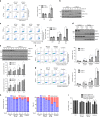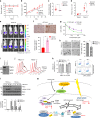Systems biology approach reveals a link between mTORC1 and G2/M DNA damage checkpoint recovery
- PMID: 30266942
- PMCID: PMC6162282
- DOI: 10.1038/s41467-018-05639-x
Systems biology approach reveals a link between mTORC1 and G2/M DNA damage checkpoint recovery
Abstract
Checkpoint recovery, the process that checkpoint-arrested cells with normal DNA repair capacity resume cell cycle progression, is essential for genome stability. However, the signaling network of the process has not been clearly defined. Here, we combine functional proteomics, mathematical modeling, and molecular biology to identify mTORC1, the nutrient signaling integrator, as the determinant for G2/M checkpoint recovery. Inhibition of the mTORC1 pathway delays mitotic entry after DNA damage through KDM4B-mediated regulation of CCNB1 and PLK1 transcription. Cells with hyper-mTORC1 activity caused by TSC2 depletion exhibit accelerated G2/M checkpoint recovery. Those Tsc2-null cells are sensitive to WEE1 inhibition in vitro and in vivo by driving unscheduled mitotic entry and inducing mitotic catastrophe. These results reveal that mTORC1 functions as a mediator between nutrition availability sensing and cell fate determination after DNA damage, suggesting that checkpoint inhibitors may be used to treat mTORC1-hyperactivated tumors such as those associated with tuberous sclerosis complex.
Conflict of interest statement
G.B.M. is on the S.A.B. of AstraZeneca, has licensed H.R.D. assay to Myriad Genetics, and has research support from Abbie, AstraZeneca, and Tesoro. The remaining authors declare no competing interests.
Figures





Similar articles
-
Upregulation of 6-phosphofructo-2-kinase (PFKFB3) by hyperactivated mammalian target of rapamycin complex 1 is critical for tumor growth in tuberous sclerosis complex.IUBMB Life. 2020 May;72(5):965-977. doi: 10.1002/iub.2232. Epub 2020 Jan 20. IUBMB Life. 2020. PMID: 31958214
-
Phosphorylation of TSC2 by PKC-δ reveals a novel signaling pathway that couples protein synthesis to mTORC1 activity.Mol Cell Biochem. 2019 Jun;456(1-2):123-134. doi: 10.1007/s11010-019-03498-8. Epub 2019 Jan 25. Mol Cell Biochem. 2019. PMID: 30684133
-
RIPK1 Promotes Energy Sensing by the mTORC1 Pathway.Mol Cell. 2021 Jan 21;81(2):370-385.e7. doi: 10.1016/j.molcel.2020.11.008. Epub 2020 Dec 2. Mol Cell. 2021. PMID: 33271062
-
Targeting cell cycle regulation via the G2-M checkpoint for synthetic lethality in melanoma.Cell Cycle. 2021 Jun;20(11):1041-1051. doi: 10.1080/15384101.2021.1922806. Epub 2021 May 9. Cell Cycle. 2021. PMID: 33966611 Free PMC article. Review.
-
Cell cycle checkpoints and DNA repair preserve the stability of the human genome.Cancer Metastasis Rev. 1995 Mar;14(1):31-41. doi: 10.1007/BF00690209. Cancer Metastasis Rev. 1995. PMID: 7606819 Review.
Cited by
-
Epithelial X-Box Binding Protein 1 Coordinates Tumor Protein p53-Driven DNA Damage Responses and Suppression of Intestinal Carcinogenesis.Gastroenterology. 2022 Jan;162(1):223-237.e11. doi: 10.1053/j.gastro.2021.09.057. Epub 2021 Sep 30. Gastroenterology. 2022. PMID: 34599932 Free PMC article.
-
Possible Novel Therapeutic Targets in Lymphangioleiomyomatosis Treatment.Front Med (Lausanne). 2020 Sep 24;7:554134. doi: 10.3389/fmed.2020.554134. eCollection 2020. Front Med (Lausanne). 2020. PMID: 33072782 Free PMC article. Review.
-
Recent Advances with KDM4 Inhibitors and Potential Applications.J Med Chem. 2022 Jul 28;65(14):9564-9579. doi: 10.1021/acs.jmedchem.2c00680. Epub 2022 Jul 15. J Med Chem. 2022. PMID: 35838529 Free PMC article. Review.
-
PLK4 Inhibition as a Strategy to Enhance Non-Small Cell Lung Cancer Radiosensitivity.Mol Cancer Ther. 2025 Sep 2;24(9):1350-1361. doi: 10.1158/1535-7163.MCT-24-0978. Mol Cancer Ther. 2025. PMID: 40296663
-
mTOR inhibition attenuates chemosensitivity through the induction of chemotherapy resistant persisters.Nat Commun. 2022 Nov 17;13(1):7047. doi: 10.1038/s41467-022-34890-6. Nat Commun. 2022. PMID: 36396656 Free PMC article.
References
Publication types
MeSH terms
Substances
Grants and funding
LinkOut - more resources
Full Text Sources
Other Literature Sources
Miscellaneous

